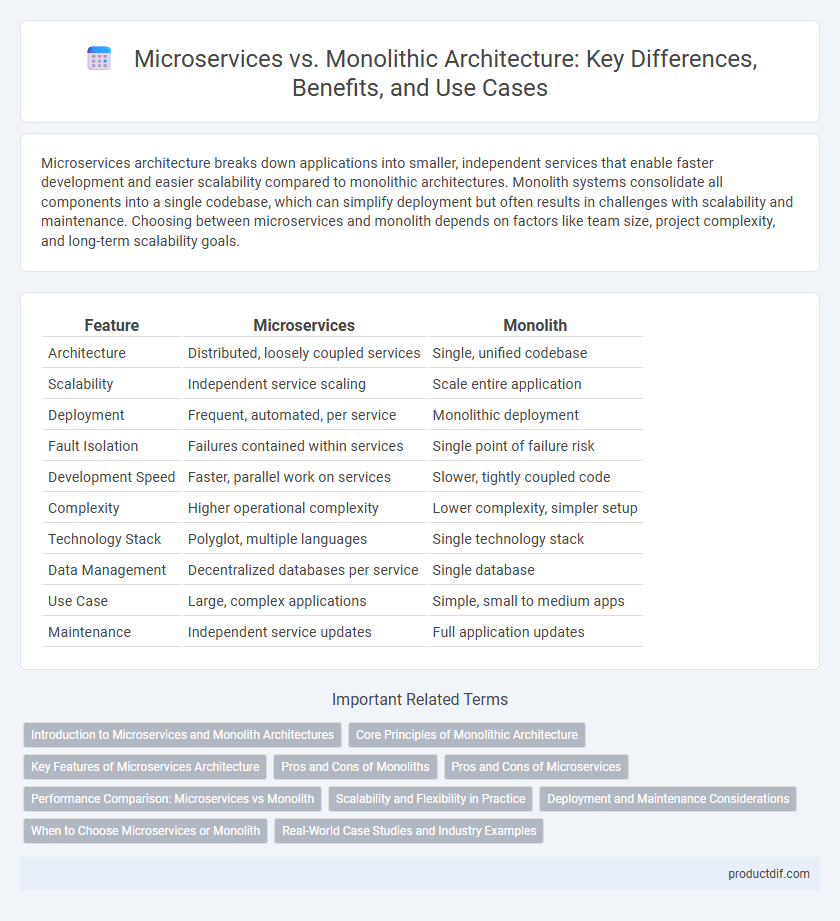Microservices architecture breaks down applications into smaller, independent services that enable faster development and easier scalability compared to monolithic architectures. Monolith systems consolidate all components into a single codebase, which can simplify deployment but often results in challenges with scalability and maintenance. Choosing between microservices and monolith depends on factors like team size, project complexity, and long-term scalability goals.
Table of Comparison
| Feature | Microservices | Monolith |
|---|---|---|
| Architecture | Distributed, loosely coupled services | Single, unified codebase |
| Scalability | Independent service scaling | Scale entire application |
| Deployment | Frequent, automated, per service | Monolithic deployment |
| Fault Isolation | Failures contained within services | Single point of failure risk |
| Development Speed | Faster, parallel work on services | Slower, tightly coupled code |
| Complexity | Higher operational complexity | Lower complexity, simpler setup |
| Technology Stack | Polyglot, multiple languages | Single technology stack |
| Data Management | Decentralized databases per service | Single database |
| Use Case | Large, complex applications | Simple, small to medium apps |
| Maintenance | Independent service updates | Full application updates |
Introduction to Microservices and Monolith Architectures
Microservices architecture decomposes applications into loosely coupled, independently deployable services, enhancing scalability and flexibility. Monolith architecture consolidates all functions into a single, unified codebase, simplifying development but limiting scalability and agility. Choosing between microservices and monolith depends on factors like team size, system complexity, and deployment frequency.
Core Principles of Monolithic Architecture
Monolithic architecture is characterized by a unified codebase where all components are tightly integrated and deployed as a single unit, ensuring simplicity in development and testing. Core principles emphasize strong coupling, shared memory space, and centralized management of business logic, which facilitates straightforward communication within the application. This design promotes easier debugging and performance optimization but can lead to challenges in scalability and flexibility compared to microservices.
Key Features of Microservices Architecture
Microservices architecture decomposes applications into independent, loosely coupled services that enable scalable and flexible deployment. Each microservice focuses on a specific business function, facilitating autonomous development, testing, and deployment cycles. Key features include decentralized data management, containerization support, and enhanced fault isolation, which improve system resilience and enable continuous delivery.
Pros and Cons of Monoliths
Monolithic architectures offer simplified deployment and straightforward development with a single unified codebase, reducing initial complexity and easing debugging. However, they can become increasingly difficult to scale and maintain as the application grows, often resulting in slower release cycles and limited flexibility for independent component updates. Performance bottlenecks and tight coupling in monoliths may hinder agility and complicate integration with modern cloud-native technologies.
Pros and Cons of Microservices
Microservices architecture allows independent deployment, scalability, and technology diversity, enhancing fault isolation and continuous delivery capabilities. It introduces complexity in service communication, increased operational overhead, and challenges in data consistency across distributed services. Organizations must balance the benefits of modularity with the demands of managing microservices infrastructure and monitoring.
Performance Comparison: Microservices vs Monolith
Microservices architectures enhance performance by enabling independent scaling of components, reducing resource contention compared to monolithic systems. Monoliths often experience performance bottlenecks due to tightly coupled modules and limited scalability, which can increase response times under heavy load. Distributed microservices allow optimized resource allocation and fault isolation, leading to improved throughput and reduced latency in complex applications.
Scalability and Flexibility in Practice
Microservices architecture enhances scalability by allowing independent deployment and scaling of individual services, adapting rapidly to varying workloads without impacting the entire system. Monolithic systems often face limitations in flexibility as changes require redeploying the whole application, leading to slower iteration cycles and increased risk during updates. In practical applications, microservices provide granular control over resource allocation and faster development velocity, essential for dynamic environments requiring frequent updates and scaling.
Deployment and Maintenance Considerations
Microservices enable independent deployment of individual components, reducing downtime and allowing faster updates compared to monolithic architectures that require redeploying the entire application. Maintenance in microservices is more manageable due to isolated codebases, facilitating targeted bug fixes and scalability, while monoliths pose challenges with tightly coupled modules impacting the entire system during updates. Containerization and orchestration tools like Kubernetes further streamline microservice deployment, contrasting with the more complex deployment pipelines needed for monolithic applications.
When to Choose Microservices or Monolith
Microservices architecture excels in large-scale, complex applications requiring independent deployment, scalability, and flexibility across diverse teams. Monolithic architecture suits smaller projects with straightforward functionality, faster development cycles, and simpler maintenance. Choose microservices for evolving, distributed systems and monoliths for tightly integrated, uncomplicated software solutions.
Real-World Case Studies and Industry Examples
Microservices architecture enables companies like Netflix and Amazon to scale services independently, improving deployment speed and fault isolation compared to traditional monoliths. In contrast, enterprises like Basecamp have maintained monolithic applications for simplicity and easier debugging, proving effective for smaller teams and less complex systems. Industry case studies reveal that organizations with rapidly evolving products often benefit from microservices, while those prioritizing stability and straightforward maintenance may prefer monolithic architectures.
Microservices vs Monolith Infographic

 productdif.com
productdif.com